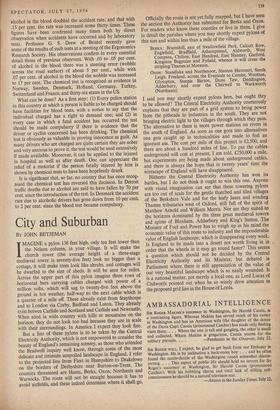City and Suburban
BY JOHN BETJEMAN IMAGINE a pylon 136 feet high, only ten feet lower than the Nelson column, in your village. It will make the church tower (the average height of a three-stage mediwval tower is seventy-five feet) look no bigger than a cottage, it will make trees look like shrubs, and cottages will be dwarfed to the size of sheds. It will be seen for miles. Across the upper part of this pylon imagine three rows of horizontal bars carrying cables charged with power of a million volts, which will sag to twenty-five feet above the ground in hot weather, half-way to the next cable which is a quarter of a mile off. These already exist from Staythorpe and to London via Corby. Bedford and Luton. They already exist betwen Carlisle and Scotland and Carlisle and Newcastle. When sited in wide country with hills or mountains on the horizon, they do not look too bad because they are in scale with their surroundings. In America I expect they look fine.
But a line of these pylons is to be taken by the Central Electricity Authority, which is not empowered to consider the beauty of England's remaining scenery, as those who attended the Bradwell inquiry well know, through some of the most delicate and intimate unspoiled landscape in England. I refer to the projected line from Fleet in Hampshire to Drakelowe on the borders of Derbyshire near Burton-on-Trent. The counties threatened are Hants, Berks, Oxon, Northants and Warwicks. The route will not be straight because it has to avoid airfields, and these indeed determine where it shall go. Officially the route is not yet fully mapped, but I have seen the section the Authority has submitted for Berks and Oxon. For readers who know these counties or live in them. I give in detail the parishes where you may shortly expect pylons of this size and within less than a mile of the village.
BERKS : Bramshill, east of Swallowfield Park, Calcott Row, Englefield, Bradfield, Ashampstead, Aldworth, West Compton, Chilton, East Hendred, East Hanney, Garford, Kingston Bagpuize and Fyiield, whence it will cross the stripling Thames at Moreton.
OXON : Standlake and Northmoor, Stanton Harcourt, South Leigh, Freeland, across the Eveniode to Combe, Wootton, Glympton, Steeple Barton, Duns Tew, Deddington, Adderbury, and over the Cherwell to Warkworth (Northants).
I said you may shortly expect pylons here, but ought they to be allowed? The Central Electricity Authority courteously explains that they are part of a grid system to bring power from the pitheads to industries in the south. They are not bringing electric light to the villages through which they pass. The alternative to them is more power stations on rivers in the south of England. As soon as one goes into alternatives one gets caught up in technicalities and made to feel an ignorant ass. The cost per mile of this project is £2,500, and there are about a hundred miles of line. To put the cables underground will cost at present. I am told, £250,000 a mile, but experiments are being made about underground cables, and there is always the hope that in twenty years' time the wirescape of England will have disappeared.
Hitherto the Central Electricity Authority has won its battles, but I do not think it ought to win this one. Anyone with visual imagination can see that these towering pylons are too out of scale for the gentle thatched and tiled villages of the Berkshire Vale and for the leafy lanes and winding Thames tributaries west of Oxford, still full of the spirit of Matthew Arnold and William Morris. Nor are they suited to the horizons dominated by the three great mediwval towers and spires of Bloxham, Adderbury and King's Sutton. The Minister of Fuel and Power has to weigh up in his mind the economic value of this route to industry and the imponderable value of English landscape, which is disappearing every week. Is England to be made into a desert not worth living in in order that the wheels in it may go round faster? This seems a question which should not be decided by the Central Electricity Authority and its Minister, but debated in Parliament where there is still appreciation of the value of our very beautiful landscape which is so easily wounded. It is a national matter, not merely a local one, as Lord Lucas of Chilworth pointed out when he so wisely drew attention to the proposed grid line in the House of Lords.


































 Previous page
Previous page